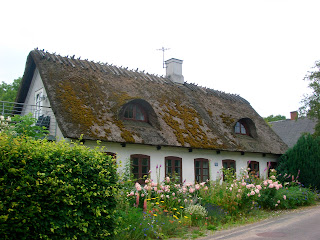July 5 - July 13:
Ferry from Denmark unloading in Putgarden, Germany

Sunset on Lolland Island


Wooden yachts with character and beauty in every harbour

Ian beside a dolman on Aero Island

Our favourite farm house

Viking museum, Roskilde

Copenhagen


We arrived in Denmark after several hours of train hopping through northern Germany and taking a ferry from Puttgarden, Germany to Lolland Island, Denmark. The trains in Germany are superb for accommodating bicycles. There are almost always elevators to the train platforms and the low floor trains are easy to get the bicycles on and off. There is a fee for taking bikes on the train, but we were happy to pay it with the great service provided. After performing bicycle gymnastics to get bikes on the train in France and Holland, we knew what to appreciate! In Germany, the cyclists all work together and with a friendly, relaxed attitude, figure out how to get all the bikes to fit when the train gets a bit crowded. We were quite impressed.
The German trains are not completely barrier-free, but they are getting very close. The bike car is also for strollers and wheelchairs, who benefit from the train and train station designs as well. From a cycling perspective, the regional trains with a flexible car for bikes, strollers and wheelchairs worked better than the cars where a specific space is allotted to the bicycle. It is much harder to maneouver the bicycles in the cars with bike specific racks. We also preferred the platforms that had a long, wide ramps rather than an elevator because it is faster and accommodates more people in a short time, which is necessary when making connections.
Our first camping experience in Denmark was exceptional, a themed western camp, including campers decked out in checkered shirts and cowboy boots and hats, and bonafide line dancing on a stage near the reception area. We left the western camp the next morning, able to leave the western hats behind because they didn't fit under our bike helmets. We headed to the next island and the lands at Tranekar Slot (castle), featuring a large semi-forested area with sculptures made with natural materials that may or may not decompose with time. Either we had become more disoriented than usual, or there has been a lot of decomposition in the park! We did manage to find a few impressive sculptures, as well as a very wet thunderstorm!
We then moved on to Aero Island, our favourite, complete with quaint harbour towns like Marstal, prehistoric dolman rocks marking ancient cemeteries, smoked fish and delicious strawberries and sugar snap peas set out at roadside farms on the honour system. After loosing many strawberries cycling over some cobblestone streets in France, we didn't take any risks, and downed the strawberries we purchased on the spot. Hint: if you head north from France, through Holland and then Denmark from June through July, you get a very long strawberry season!
The Marstal harbour is large for the small town that it is and we enjoyed seeing all the boats, with the classic wooden sailing vessels competing with the sleek new yachts for attention. The boats are also terrific at the Svendborg harbour on the next island over, Funan.
The cycling in Denmark is fabulous. The islands are large enough to feel like you are going somewhere, but small enough to encourage a relaxed pace. The rolling countryside has Baltic Sea views around almost every corner and the roads are quiet, and well, lovely. Almost every farm has sheep, horses or cows, many taking a casual interest in passing cyclists. Like the other countries we have been in, there are a surprising number of gorgeous horses at the farms we pass.
Multi-modal transportation is key in Denmark as you cannot go very far without taking a ferry. We traversed five islands in four days, ending with Zealand, where Copenhagen is located. On route to Copenhagen, we visited the town of Roskilde where there is a Viking museum with a focus on the Viking boats. There is an extensive boat exhibit in the harbour adjacent to the museum, making us think about how the Canoe Museum in Peterborough could function on Little Lake downtown. Luckily or not, we had just missed the annual Roskilde Rock Festival. This event is run by almost everyone in the community, nets a couple million dollars a year, all of which goes to local sports teams, cultural events, museums, environmental initiatives, etc. Quite an amazing feat for a small city.
In Copenhagen, we enjoyed the jazz festival and watched the final match of the World Cup soccer championships on a large screen TV at the makeshift campground (all the buildings are portable) with 50 or so other campers of various origins. We didn't clue in until the end of the game, with a winning goal from Spain, that we were in a minority rooting for Holland... a tolerant crowd! Copenhagen is a fascinating city, full of character and contrasts, from sophisticated jazz venues (dixieland on the streets, cool jazz in the clubs during the festival), to anarachy in Christiana to waterside promenades. We enjoyed it all.
Cycling is big in Copenhagen, like Amsterdam, but the streets are wider and there is not as much predictability of cycling infrastructure. In Denmark, a cyclist must make a left hand turn in two motions like an upsidedown L. It is not legal to move into the left lane and then make a turn. This is likely due to the history of the separated cycling tracks along the side of the road. Even with the volume of cyclists present, the L left hand turns worked quite well.
No comments:
Post a Comment